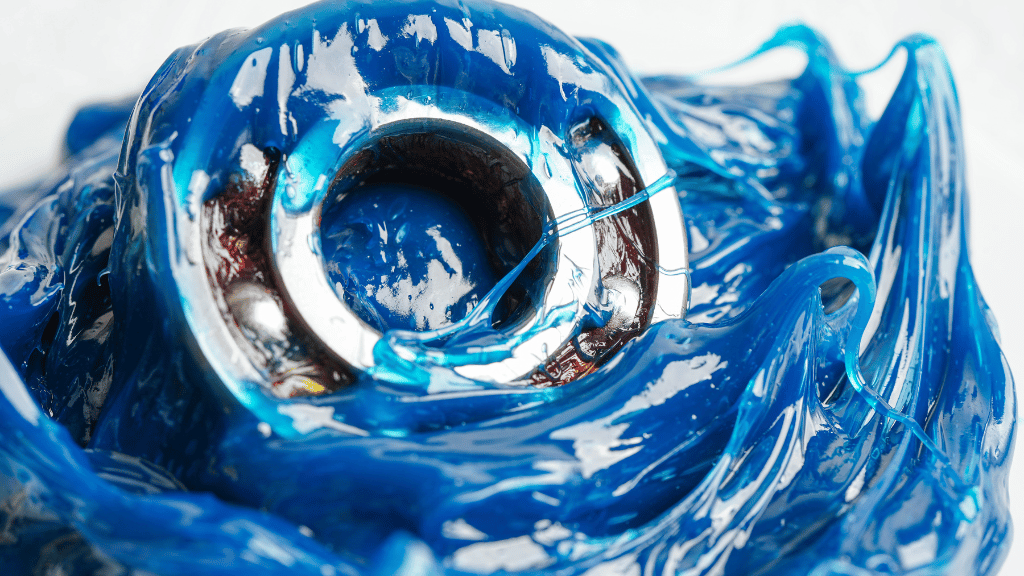How slow can you go with Ultrasound
Observations on a slow speed bearing survey.
I keep getting questions on the effectiveness of ultrasound on slow speed bearings.
One of the advantages of Ultrasound is, that it keeps its effeteness even for ultra-slow bearings. I often do reports on bearings that turn at 1RPM or slower. We have also done successful work on slew bearings, that took 45 minutes to turn 260 degrees. So, my experience is that as long as there is movement and friction or potential for friction, it should work. As an example of the possibilities of using ultrasound on slow-moving bearings, I drafted this short observation abstract from one of the reports we did.
Outline
The brief was to do a follow-up survey on slow speed bearings (some only turning at 1RPM) on a metal conveyor belt, moving large rock fragments.
A total of 16 slow speed bearings were surveyed. Most of the readings were consistent with bearings in a good condition. Unfortunately, we did find 6 bearings of interest that showed deterioration from the previous survey.
The two different surveys were done only 4 months apart
The Methodology of the Inspection.
A UE Systems, Ultraprobe 15 000 was used to take the ultra sound readings.
The sound recordings were then entered into the UE Systems DMS Software and the recordings analysed in the UE Systems Spectralisyer 4.2.6 software.
There are four different ways to analyse bearings with ultrasound technology:
1.1 Audible quality
Just by listening to the sound of a bearing, potential problems can be identified. To listen to the potential fault recordings, go to the UE Systems website (www.uesystems.com) where you can listen to sound file examples.
1.2 Comparative
Comparative analyses were done between similar bearings, and between the earlier readings and current readings.
Examples of the individual results of the bearings of interest will be discussed in the main part of this observation document.
1.3 Historical trending
We could do historical trending on the bearings on the conveyors as we had recordings taken four months earlier. We found deterioration of various levels in six of the 16 bearings we surveyed. I will show four in the document.
1.4 Analysis with software
All the recorded sound files were analysed in the UE Systems Spectralisyer Software. Several of the bearings showed Impacts on the Time Wave Form Graphs and further action was recommended.
Example of a bearing in good condition
Figure 1: Example of a bearing in a good condition
In this example of a TWF of a bearing in a good condition. There are no impacts of interest and the graph line is smooth and there are no outstanding peak Impacts visible.
Example of a bearing in bad condition
Figure 2: Example of a bearing in a bad condition
In this example of a bearing in a bad condition; there are numerous Impacts in a repetitive pattern visible.
Slow Speed Bearings
One of the big advantages of using Ultrasound on bearings, is that the speed of the bearing turning is not a limitation. We often do surveys on bearings moving at 1RPM, such as some of the bearings in this document. The slowest bearings we have done to date, was a slew bearing taking 45 minutes to turn 260 degrees in one direction.
My experience is that as long as there is movement with friction or potential for friction Ultrasound should work. There are a few conditions you need to consider e.g:
- You may have to change the frequency to find the best recording. I have had to go down to between 20 and 25 kHz to get usable recordings on ultra-slow speed bearings.
- You need to record at least one complete full revolution. So, for a bearing that turns at 1RPM the recording needs to be at least 1 minute long.
- When you do ultra-slow speed slew bearings that turn in both directions you need to do recordings of the movement in both directions.
- Make sure there is the highest possibility for friction when you take the samples. For instance, there is a big difference in the potential for friction between loaded and empty conveyor belts.
- Always be on the lookout for competing ultrasound.
These are only some of the most obvious conditions and is not a full list.
I would be interested to hear from other Ultrasound technicians to add their experience regarding these points as well as additional points we can add to the list.
Competing ultrasound
As we were working on a metal conveyor belt (potential metal on metal friction of the belt moving) carrying large rock fragments (potential friction caused by rock fragments on moving conveyor belt) competing ultrasound was always going to be a possibility. So, to understand the potential for competing ultrasound caused by the metal conveyor belt, we took sound samples from the metal cage close to the metal conveyer belt, in between the bearings as a control recording.
Figure 3 Control recording on metal cage.
Figure 3 shows one of the control recordings, taken off the metal frame of the conveyor to see if the metal conveyor belt would give competing ultrasound that may interfere in the recording of the bearing. The recording showed there was no competing ultrasound with the potential to interfere with the recording of the bearings.
Recordings of bearings
Example 1: Left Front Bearing of Conveyor 1; First recording August.
Figure 4 Recording 1 of Example 1- August
This recording was taken in August and was consistent with the recording expected of a bearing in a good condition.
Example 1: Left Front Bearing of Conveyor 1; Second Recording December.
Figure 5 Recording 2 of Example 1 - December
The Ultrasound recording taken in December of the same bearing shows Impacts similar to the Impacts of a bearing in early stages of wear. This is a visible deterioration from the recording made in August (Figure 4) In this case one revolution took 40 seconds.
Example 1: Left Front Bearing of Conveyor 2; First Recording August
Figure 6 Recording 1 of Example 2 - August
This recording was taken in August and was consistent with the recording expected of a bearing of potential Interest. In the August survey there were two bearings (out of the 16 tested) highlighted as potential bearings of interest. This one had the most visible increased Impacts of the two bearings highlighted.
Example 2. Left Front Bearing of Conveyor 2; Second Recording December
Figure 7: Recording 2 of Example 2 - December
These impacts are dramatic and is consistent with a bearing in an advance stage of wear. It is interesting to note that the recording of August only showed isolated Impacts of interest but the current reading is a vastly more intense.
Example 3: Right Front Bearing of Conveyor 2; Fist recording August
Figure 8: Recording 1 of Example 3 – August
This recording was taken in August and was consistent with the recording expected of a bearing in a good condition.
Example 3: Right Front Bearing of Conveyor 2; Second Recording December
Figure 9: Recording 2 of Example 3 - December
The impacts in this recording again showed a dramatic increase from the recording taken in August, and is consistent with a bearing in an advance stage of wear. It is, however, interesting to note that the recording of August (Figure 8) showed no impacts of interest whatsoever. It is also interesting that both bearings Figure 7 and Figure 9 on either side of the shame shaft showed such dramatic deterioration in a relatively short time.
Example 4 Left from Bearing of Conveyor 3: Second Recording – December
Figure 10: Recording 2 of Example 3 - December
This bearing shows numerous Impacts of interest that is consistent with a bearing that needs further attention. It is also interesting to note that the extended Impacts are consistent with both short intense, and long large, areas friction that seems to repeat.
Refer to Impacts marked as “A” and “B” in Figure 10
The Figure 11 shows a short 92.9 millisecond cut of incident “A” (the first extended incident) on the graph and Figure 12 shows the second 92.9 millisecond cut of incident “B” (the second thin extended incident) on Figure 10, shows intense friction over a small area.
Figure 11: Recording 2 of Example 3 – December
An analysis of a 92.9 millisecond of point A in main graph, covers the full 92.9 millisecond and show friction over an extended area
Figure 12: Recording 2 of Example 3 - December
Analysis of a 92.9 millisecond of point B in main graph, shows intense friction over only small area of the recording.
As this is a general example of the recordings possible when using Ultrasound in slow moving bearings, I specifically did not add any discussions on the potential causes of the faults in the bearings, nor did I give any specific recommendations as the next steps, as such recommendations will normally be specific to a bearing, based on the working and operational requirements of each bearing and would not be appropriate for a general example such as this.
This observation document is for information and development purposes only and was drafted by Andre Jooste ISO Level II, February 2021. E: a.jooste@iinet.net.au.
Related content: Ultrasound inspections training
.png?width=190&name=IPA%20Logo%20Transparent%20(Hi-Res).png)





